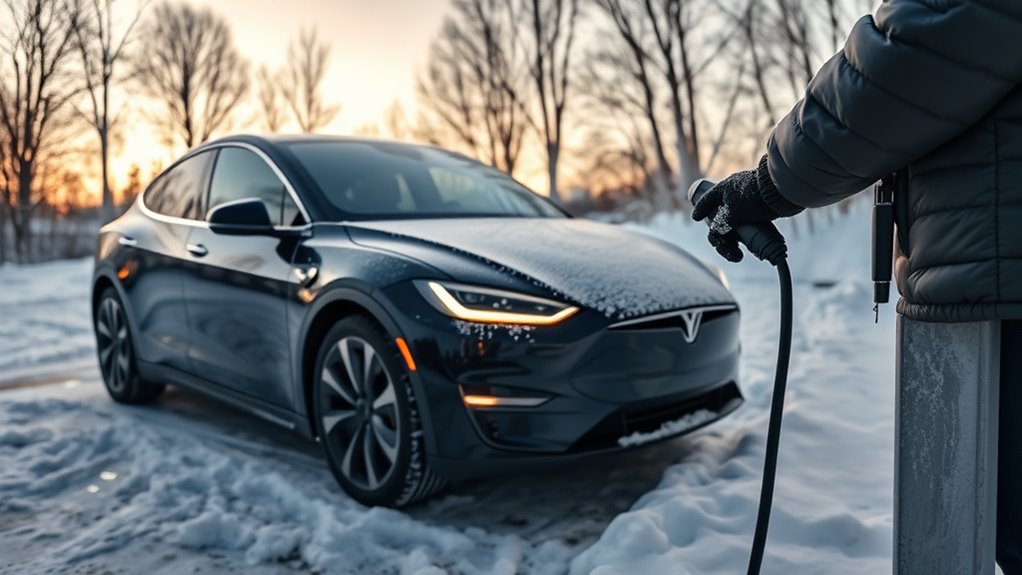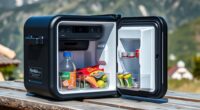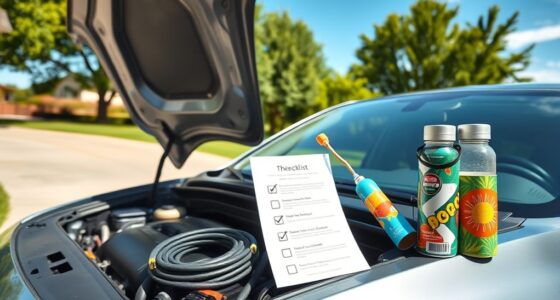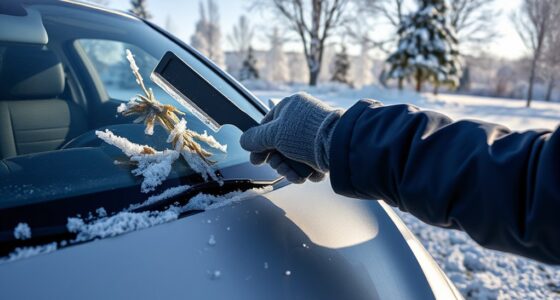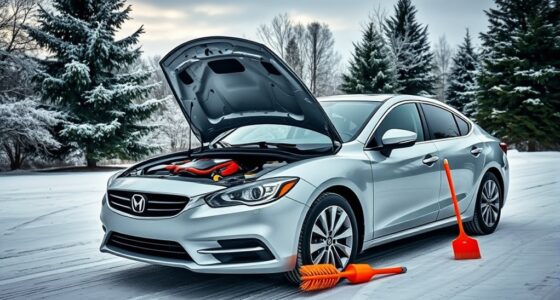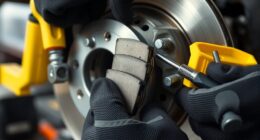To prepare your EV for winter, start by pre-heating your car before trips and using remote charging to keep the battery warm. Switch to winter tires or all-season tires with good grip, and check tire pressure regularly as cold air drops pressure. Make certain your thermal management and heating systems work well for comfort and safety. Keep an emergency kit handy and plan your trips carefully. For more expert tips, explore how to keep your electric car running smoothly in cold weather.
Key Takeaways
- Pre-heat your EV and battery before driving to optimize performance and reduce energy drain.
- Switch to winter or all-season tires with deeper treads for better traction on snow and ice.
- Keep tires properly inflated to maintain handling and prevent slips in cold conditions.
- Regularly check and maintain your vehicle’s thermal management and heating systems for efficient operation.
- Carry an emergency kit with blankets, snacks, and safety supplies for winter driving safety.
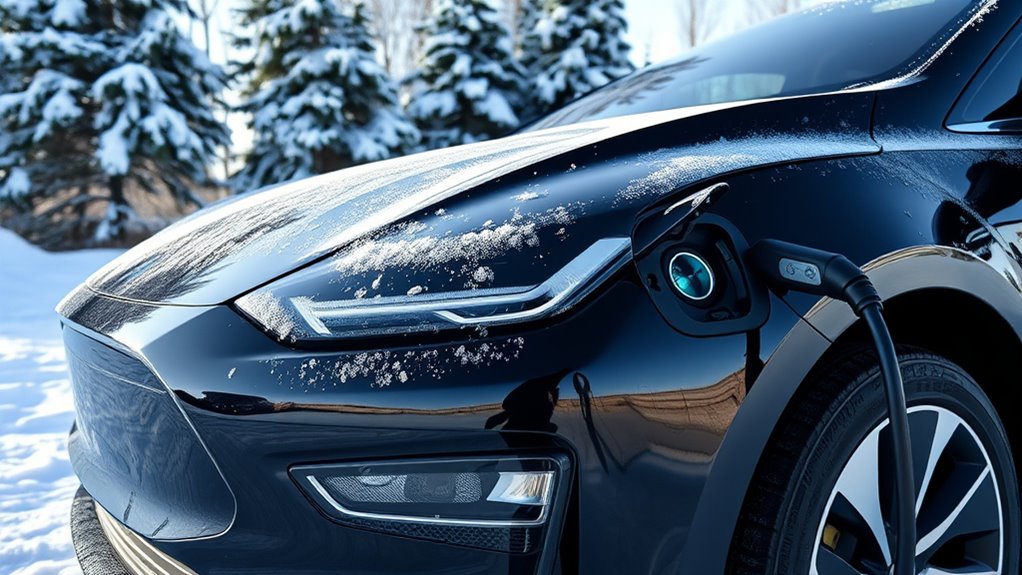
Winter can be tough on your electric vehicle, but with some simple preparations, you can guarantee it runs smoothly in cold weather. One of the most critical aspects is proper battery management. Cold temperatures reduce a battery’s efficiency, causing it to drain faster and potentially limiting your range. To combat this, consider pre-heating your EV before you start your trip. Many models feature remote or scheduled charging that can warm the battery while still plugged in, preserving energy for driving. Additionally, avoid letting your battery deplete completely, as deep discharges can harm its longevity in low temperatures. Keeping your battery properly charged and maintaining a moderate state of charge helps ensure peak performance. If your vehicle has thermal management systems, make sure they’re functioning correctly, as these help regulate battery temperature and prevent it from getting too cold or overheating. Proper battery health maintenance is essential for optimal performance in winter conditions.
Tire traction is another essential factor for winter driving safety. Cold weather causes tires to lose grip, especially if they’re not equipped with the right type of tires. Switching to winter or all-season tires with deeper treads and softer rubber compounds greatly improves traction on snow and ice. Check your tire pressure regularly, since cold air causes pressure to drop, impacting handling and efficiency. Properly inflated tires maintain better contact with the road, reducing the risk of slipping. You might also consider adding tire chains or anti-slip mats if you frequently drive on icy roads. These accessories provide extra grip when conditions are particularly treacherous. Remember, your tires are your primary contact point with the road, so investing in their condition and traction is essential for safe winter driving.
In addition to battery management and tire traction, you’ll want to keep your vehicle’s systems well-maintained. Make sure your heating and defrosting systems work efficiently, as winter conditions demand clear visibility. Regularly check your windshield washer fluid—use a formula designed for low temperatures to prevent freezing. Keep an emergency kit in your car, including blankets, a flashlight, and some snacks, in case you get stranded. Planning your trips around the weather forecast can help you avoid the worst conditions, and always allow extra time for warm-up and de-icing. By staying proactive about these preparations, you’ll not only extend your EV’s lifespan but also enjoy safer, more reliable driving throughout the winter months.
Frequently Asked Questions
How Does Cold Weather Affect EV Battery Performance?
Cold weather impacts your EV battery by reducing its performance. You might notice decreased range because the battery cooling system works harder to maintain ideal temperature, which can drain energy efficiency. The cold slows chemical reactions inside the battery, leading to less power output. To maintain performance, keep your EV warm when parked and pre-condition the cabin while plugged in, helping conserve battery life and improve overall efficiency during winter months.
Can I Use Standard Charging Stations in Winter?
Think of using a standard charging station in winter as riding a horse-drawn carriage in a modern city. You can usually still charge your EV, but cold weather may slow down charging speeds. Make certain of charging station compatibility beforehand, and follow winter charging tips like preconditioning your battery. Cold temperatures can affect charging efficiency, so plan for slightly longer charging times, and keep your vehicle and charger connections clear of snow and ice.
What’S the Best Way to Keep My Ev’S Interior Warm?
To keep your EV’s interior warm, use the heated seats and cabin heater efficiently. Activate seat heating first, as it warms you quickly without draining the battery too much. Make sure your vehicle has good interior insulation, which helps retain heat longer. Precondition your car while plugged in, so the cabin warms up without using battery power. This way, you stay cozy and extend your driving range in cold weather.
Does Cold Weather Impact Regenerative Braking?
Cold weather effects can reduce regenerative braking efficiency because low temperatures slow down battery chemistry, limiting energy recovery. You might notice less braking energy regeneration during winter drives, making your EV rely more on traditional brakes. To minimize this, keep your battery warm with preconditioning or parking in a garage. This way, you maintain better regenerative braking efficiency, ensuring safer, more efficient stops even in cold conditions.
How Often Should I Check Tire Pressure in Winter?
You should check your tire pressure regularly during winter, ideally once a month, to guarantee ideal tire pressure maintenance. Cold weather causes tire pressure to drop, reducing grip and efficiency. Seasonal tire checks help you catch any pressure drops early, so you can inflate your tires to the recommended levels. Staying proactive with these checks keeps your EV safe and performing well in winter conditions.
Conclusion
As winter approaches, equipping your EV is like preparing a trusted steed for a snowy adventure. By following these cold weather tips, you’ll guarantee your car remains a reliable companion through frosty mornings and icy roads. Think of your vehicle as a delicate dance partner—not just surviving, but thriving in the winter waltz. With a little prep, you’ll glide smoothly into the season, confident and ready to conquer the cold months ahead.
